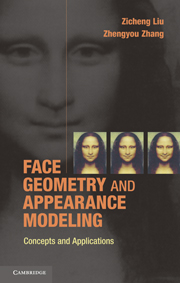10 - Model-based tracking and gaze correction
from PART III - APPLICATIONS
Published online by Cambridge University Press: 01 June 2011
Summary
The problem of head pose tracking has been studied for many years. Many applications require head pose information such as attention detection, vision-based interface, head gesture recognition, and eye-gaze correction. 3D head pose is also extremely useful in face recognition and facial expression recognition in handling pose variations. Not surprisingly, there has been a wide variety of work on 3D head tracking. The paper [123] has a nice survey.
Virtually all the work on face tracking takes advantage of the constrained scenario: Instead of using a generic tracking framework that views the observed face as an arbitrarily object, a model-based approach, which incorporates knowledge about face geometry, appearance, and facial deformations, is favored. The tracking techniques can be roughly classified into the following categories.
Optical flow: Black and Yacoob [18] developed a regularized optical-flow method in which the head motion is tracked by interpretation of optical flow in terms of a planar two-dimensional patch. Basu et al. [10] generalized this approach by interpreting the optical flow field using a 3D model to avoid the singularities of a 2D model. Better results have been obtained for large angular and translational motions. DeCarlo and Metaxas [44] used optical flow as a hard constraint on a deformable detailed model. Other optical-flow-based methods include [34, 125].
- Type
- Chapter
- Information
- Face Geometry and Appearance ModelingConcepts and Applications, pp. 217 - 256Publisher: Cambridge University PressPrint publication year: 2011



